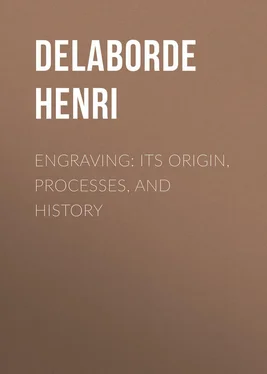Henri Delaborde - Engraving - Its Origin, Processes, and History
Здесь есть возможность читать онлайн «Henri Delaborde - Engraving - Its Origin, Processes, and History» — ознакомительный отрывок электронной книги совершенно бесплатно, а после прочтения отрывка купить полную версию. В некоторых случаях можно слушать аудио, скачать через торрент в формате fb2 и присутствует краткое содержание. Жанр: foreign_antique, foreign_prose, на английском языке. Описание произведения, (предисловие) а так же отзывы посетителей доступны на портале библиотеки ЛибКат.
- Название:Engraving: Its Origin, Processes, and History
- Автор:
- Жанр:
- Год:неизвестен
- ISBN:нет данных
- Рейтинг книги:5 / 5. Голосов: 1
-
Избранное:Добавить в избранное
- Отзывы:
-
Ваша оценка:
- 100
- 1
- 2
- 3
- 4
- 5
Engraving: Its Origin, Processes, and History: краткое содержание, описание и аннотация
Предлагаем к чтению аннотацию, описание, краткое содержание или предисловие (зависит от того, что написал сам автор книги «Engraving: Its Origin, Processes, and History»). Если вы не нашли необходимую информацию о книге — напишите в комментариях, мы постараемся отыскать её.
Engraving: Its Origin, Processes, and History — читать онлайн ознакомительный отрывок
Ниже представлен текст книги, разбитый по страницам. Система сохранения места последней прочитанной страницы, позволяет с удобством читать онлайн бесплатно книгу «Engraving: Its Origin, Processes, and History», без необходимости каждый раз заново искать на чём Вы остановились. Поставьте закладку, и сможете в любой момент перейти на страницу, на которой закончили чтение.
Интервал:
Закладка:
We have now arrived at that decisive moment when engraving, endowed with fresh resources, was practised for the first time by real masters. Up to the present, the trifling ability and skill possessed by certain wood-cutters and the peculiar methods of dotted engraving have been the only means by which we could measure the efforts expended in the search for new technical methods, or in their use when discovered. We have now done with such hesitating and halting progress. The art of printing from plates cut in intaglio had no sooner been discovered by, or at least dignified by the practice of, a Florentine goldsmith, than upon every side fresh talent was evoked. In Italy and Germany it was a question of who should profit most and quickest by the advance. A spirit of rivalry at once arose between the two schools; and fifteen years had not elapsed since Italian art had given its note in the works of the goldsmith engravers of the school of Finiguerra, before German art had found an equally definite expression in the works of the Master of 1466. But, before examining this simultaneous progress, we shall have to say a few words on the historical part of the question, and to return to the origin of the process of intaglio engraving, as we have already done with the origin of engraving in relief. This part of our subject must be briefly and finally disposed of; we may then altogether abandon the uncertain ground of archæological hypothesis.
CHAPTER III.
FIRST ATTEMPTS AT INTAGLIO ENGRAVING. THE NIELLI OF THE FLORENTINE GOLDSMITHS. PRINTS BY THE ITALIAN AND GERMAN PAINTER-ENGRAVERS OF THE FIFTEENTH CENTURY
We have seen that Gutenberg's permanent improvements in the method of printing resulted in the substitution, so far as written speech was concerned, of a mode of reproduction almost infinitely fruitful, and even rapid when compared to the slowness and the limited resources of the xylographic method. Typography was destined to abolish the use of block printing, and more particularly of caligraphy, which, till then, had occupied so many pious and patient hands both in monasteries and in schools. The art of printing from engravings worked similar mischief to the illuminator's craft. Such were, before long, the natural consequences of the progress made; and, we may add, such had been from the first the chief object of these innovations.
Perhaps this double revolution, so potent in its general effect and in its influence on modern civilisation, may have appeared to those engaged in it no more important than a purely industrial improvement. Surely, for instance, we do no injustice to Gutenberg if we accept with some reserve the vast political and philosophical ideas, and the purposes of universal enfranchisement, with which he has been sometimes credited? Probably the views of the inventor of printing reached neither so far nor so high. He did not intend to figure as an apostle, nor did he regard himself as devoted to a philanthropic mission, as we should put it in the present day. He considered himself no more than a workman with a happy thought, when he proposed to replace the lengthy and costly labours of the copyist by a process so much cheaper and so much more expeditious.
A somewhat similar idea had already occurred to the xylographic printers. Even the title of one of the first books published by them, the "Biblia Pauperum," or "Bible for the Poor," proved their wish to place within the reach of the masses an equivalent to those illuminated manuscript copies which were only obtainable by the rich. One glance at the ancient xylographic collections is enough to disclose the spirit in which such work was undertaken, and the design with which it was conceived. The new industry imitated in every particular the appearance of those earlier works due to the pen of the scribe or to the brush of the illuminator; and, perhaps, the printers themselves, speculating on the want of discernment in the purchasing public, thought less of exposing the secret of their method than of maintaining an illusion.
In most of the xylographic books, indeed, the first page is quite without ornamentation. There are neither chapter-headings nor ornamental capitals; the blank space seems to await the hand of the illuminator, who should step in to finish the work of the printer, and complete the resemblance between the printed books and the manuscript. Gutenberg followed; and even he, although less closely an imitator of caligraphy, did not himself disdain at first to practise some deception as to the nature of his method. It is said that the Bible he printed at Mayence was sold as manuscript; and the letterpress is certainly not accompanied by any technical explanation, or by any note of the printer's name or the mode of fabrication. Not till somewhat later, when he published the "Catholicon," did Gutenberg avow that he had printed this book "without the help of reed, quill, or stylus, but by means of a marvellous array of moulds and punches." Even in this specimen of a process already settled and finally disclosed to the public, the capital letters were left blank in the printing, and were afterwards filled in with brush or pen. It was a farewell salutation to the past, and the latest appearance of that old art which was now doomed to pass away before the new, and to leave the field to the products of the press.
Did the inventor of the art of printing from plates cut in intaglio, like the inventor of the art of typography, only wish at first to extend to a larger public what had hitherto been reserved for the favoured few? Was early engraving but a weapon turned against the monopoly of the miniature painter? We might be tempted to think so, from the number of manuscripts belonging to the second half of the fifteenth century, in which coloured prints, surrounded by borders also coloured, are set opposite a printed text, apparently in order to imitate as nearly as possible the familiar aspect of illuminated books. Next in turn came printed books with illustrations, and loose sheets published separately for every-day use. The Italian engravers, even before they began to adorn with the burin those works which have been the most frequently illustrated – such, for instance, as the religious handbooks and the poem of Dante – employed the new process from as early as 1465, to assure their calendars a wider publicity. But let us return to the time when engraving was yet in its early stages, and when – by chance, by force of original genius, or by the mere completion of what had been begun by other hands – a Florentine goldsmith, one Maso Finiguerra, succeeded in fixing on paper the impression of a silver plate on which lines had been engraved in intaglio and filled with black.
Finiguerra's great glory does not, however, lie in the solution of the practical difficulty. Amongst the Italians none before him had ever thought of trying to print from a work engraved in incised line or intaglio on metal; and therefore, at least, in his own country, he deserved the honours of priority. But the invention of the process – that is, in the absolute and literal sense of its name, the notion of reproducing burin work by printing – was certainly not peculiar to Finiguerra. Unconscious of what was passing elsewhere, he may have been the first in Florence to attempt this revolution in art; but beyond the frontiers of Italy, many had already employed for the necessities of trade that method which it was his to turn into a powerful instrument of art. His true glory consists in the unexpected authority with which he inaugurated the movement. Although it may be true that there are prints a few years older than any Florentine niello – the German specimens of 1446, discovered but the other day by M. Renouvier 15 15 "Une Passion de 1446. Suite de Gravures au Burin, les premières avec Date." Montpellier, 1857.
or the "Virgin" of 1451 described by M. Passavant 16 16 "Archiv für die Zeichnenden Künste," 1858.
– it cannot change the real date of the invention of engraving; that date has been written by the hand of a man of talent, the first engraver worthy of the name of artist.
Интервал:
Закладка:
Похожие книги на «Engraving: Its Origin, Processes, and History»
Представляем Вашему вниманию похожие книги на «Engraving: Its Origin, Processes, and History» списком для выбора. Мы отобрали схожую по названию и смыслу литературу в надежде предоставить читателям больше вариантов отыскать новые, интересные, ещё непрочитанные произведения.
Обсуждение, отзывы о книге «Engraving: Its Origin, Processes, and History» и просто собственные мнения читателей. Оставьте ваши комментарии, напишите, что Вы думаете о произведении, его смысле или главных героях. Укажите что конкретно понравилось, а что нет, и почему Вы так считаете.












